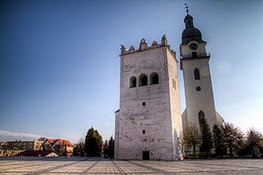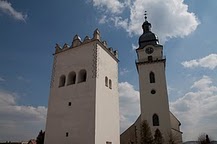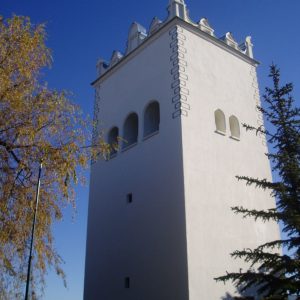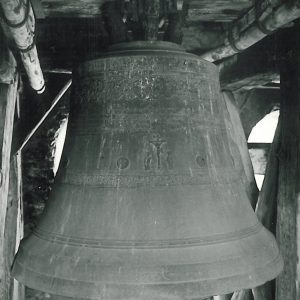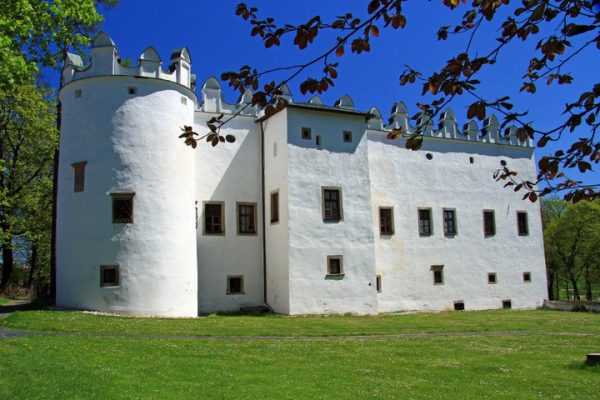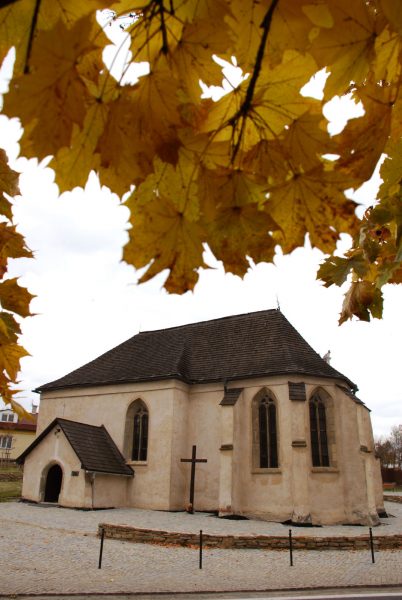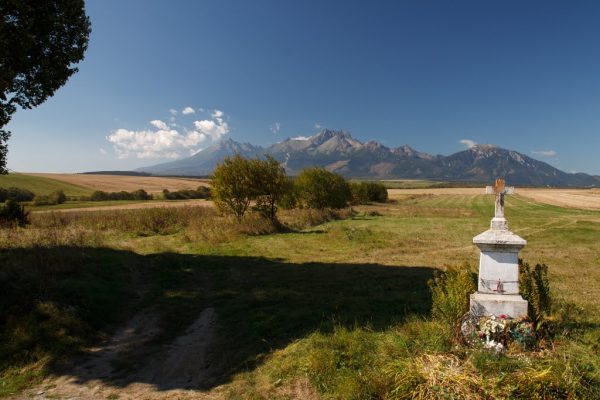7. Renesančná zvonica
![]() Zvonica, ako stavebný typ, sa objavuje na území východného Slovenska a Spiša v súvislosti so šírením reformácie. Renesančný sloh sa preto stáva akýmsi výrazom reformácie. Zvonica je profánna stavba situovaná na západ od kostola, mimo jeho ohrady. Bloková stavba na štvorcovom pôdoryse, ktorá je v hornej časti rozdelená zvukovými oknami – otvormi. Zvonicu v Spišskej Belej postavilo mesto v rokoch 1589-1590. Jej hmota je bez sgrafitovej výzdoby, ktorá je typickým renesančným výzdobným prvkom. Stavba je zakončená motívom štítkovej atiky, ktorá je špecifikom východoslovenskej renesancie. Vo zvonici sa nachádzajú 3 zvony. Jeden je z roku 1573, druhý z roku 1651 a tretí zvon vážiaci 3 900 kg pochádza z roku 1558. V roku 1749 praskol a bol znovu uliaty v roku 1750.
Zvonica, ako stavebný typ, sa objavuje na území východného Slovenska a Spiša v súvislosti so šírením reformácie. Renesančný sloh sa preto stáva akýmsi výrazom reformácie. Zvonica je profánna stavba situovaná na západ od kostola, mimo jeho ohrady. Bloková stavba na štvorcovom pôdoryse, ktorá je v hornej časti rozdelená zvukovými oknami – otvormi. Zvonicu v Spišskej Belej postavilo mesto v rokoch 1589-1590. Jej hmota je bez sgrafitovej výzdoby, ktorá je typickým renesančným výzdobným prvkom. Stavba je zakončená motívom štítkovej atiky, ktorá je špecifikom východoslovenskej renesancie. Vo zvonici sa nachádzajú 3 zvony. Jeden je z roku 1573, druhý z roku 1651 a tretí zvon vážiaci 3 900 kg pochádza z roku 1558. V roku 1749 praskol a bol znovu uliaty v roku 1750.
7. Renaissance Bell tower
![]() The architectural form of the bell tower starts appearing on the territory of Eastern Slovakia and throughout the Spiš region in connection with the spreading of Reformist thought. As such, the Renaissance style is an expression of the Reformation. The bell tower is located in front of the church, on its western side, outside of its surrounding walls. It is a square construction, which in its upper part is divided by sounding windows. The bell tower in Spišská Belá was built by the town between 1589 -1590. Its body is not decorated with sgraffito, although that was a typical Renaissance ornament. The structure is completed by an attic with graphite decorations, a style element of the Eastern Slovak Renaissance. There are a total of three bells in the tower, one dates from 1573, the second from 1651 and the third, which weighs 3900 kg, dates from 1558. It burst in 1740 and was newly cast in 1750.
The architectural form of the bell tower starts appearing on the territory of Eastern Slovakia and throughout the Spiš region in connection with the spreading of Reformist thought. As such, the Renaissance style is an expression of the Reformation. The bell tower is located in front of the church, on its western side, outside of its surrounding walls. It is a square construction, which in its upper part is divided by sounding windows. The bell tower in Spišská Belá was built by the town between 1589 -1590. Its body is not decorated with sgraffito, although that was a typical Renaissance ornament. The structure is completed by an attic with graphite decorations, a style element of the Eastern Slovak Renaissance. There are a total of three bells in the tower, one dates from 1573, the second from 1651 and the third, which weighs 3900 kg, dates from 1558. It burst in 1740 and was newly cast in 1750.
7. Der Renaissance-Glockenturm
![]() Der Glockenturm als Bautyp kommt in der Ostslowakei und in der Zips im Zusammenhang mit der Ausbreitung der Reformation auf. Der Renaissancestil wird deshalb gleichsam zur Ausdrucksform der Reformation. Der Glockenturm ist ein profanes Bauwerk, das westlich der Kirche und außerhalb ihrer Umfriedung steht. Er ist ein Blockbau über quadratischem Grundriss, der in seinem oberen Teil durch Schallfenster unterteilt ist. Den Glockenturm von Zipser Bela hatte die Stadt in den Jahren 1589 – 1590 errichten lassen. Er weist keine Sgraffiti auf, das typische Dekorelement der Renaissance. Das Bauwerk wird durch das Motiv einer Giebelattika abgeschlossen, was ein Spezifikum der ostslowakischen Renaissance ist. Im Glockenturm befinden sich drei Glocken. Die älteste, die 3900 Kilo wiegt, stammt aus dem Jahre 1558. 1749 erhielt sie einen Riss und wurde 1750 erneut gegossen. Die zweitälteste Glocke stammt aus dem Jahre 1573 und die dritte datiert in das Jahr 1651.
Der Glockenturm als Bautyp kommt in der Ostslowakei und in der Zips im Zusammenhang mit der Ausbreitung der Reformation auf. Der Renaissancestil wird deshalb gleichsam zur Ausdrucksform der Reformation. Der Glockenturm ist ein profanes Bauwerk, das westlich der Kirche und außerhalb ihrer Umfriedung steht. Er ist ein Blockbau über quadratischem Grundriss, der in seinem oberen Teil durch Schallfenster unterteilt ist. Den Glockenturm von Zipser Bela hatte die Stadt in den Jahren 1589 – 1590 errichten lassen. Er weist keine Sgraffiti auf, das typische Dekorelement der Renaissance. Das Bauwerk wird durch das Motiv einer Giebelattika abgeschlossen, was ein Spezifikum der ostslowakischen Renaissance ist. Im Glockenturm befinden sich drei Glocken. Die älteste, die 3900 Kilo wiegt, stammt aus dem Jahre 1558. 1749 erhielt sie einen Riss und wurde 1750 erneut gegossen. Die zweitälteste Glocke stammt aus dem Jahre 1573 und die dritte datiert in das Jahr 1651.
7. Renesansowa dzwonnica
![]() Dzwonnica jako rodzaj samodzielnej budowli pojawiła się na terenie Słowacji Wschodniej i Spiszu wraz z reformacją. Styl renesansowy staje się więc swoistym wyrazem protestantyzmu. Dzwonnica jako budowla świecka sytuowana jest po stronie zachodniej kościoła, poza jego ogrodzeniem. Zbudowana jest na planie czworokąta, górną część dzielą okna – otwory. Dzwonnicę w Białej Spiskiej miasto postawiło w latach 1589 – 1590. Nie jest pokryta sgraffito, będącym w okresie renesansu typowym elementem zdobniczym. Wieńczą ją attyki, o kształcie charakterystycznym dla renesansu wschodniosłowackiego. W dzwonnicy wiszą trzy dzwony. Jeden pochodzi z 1573 roku, drugi z 1651, a trzeci ważący 3900 kg z roku 1558. Dzwon ten w roku 1749 pękł, ponownie był odlany w 1750 roku.
Dzwonnica jako rodzaj samodzielnej budowli pojawiła się na terenie Słowacji Wschodniej i Spiszu wraz z reformacją. Styl renesansowy staje się więc swoistym wyrazem protestantyzmu. Dzwonnica jako budowla świecka sytuowana jest po stronie zachodniej kościoła, poza jego ogrodzeniem. Zbudowana jest na planie czworokąta, górną część dzielą okna – otwory. Dzwonnicę w Białej Spiskiej miasto postawiło w latach 1589 – 1590. Nie jest pokryta sgraffito, będącym w okresie renesansu typowym elementem zdobniczym. Wieńczą ją attyki, o kształcie charakterystycznym dla renesansu wschodniosłowackiego. W dzwonnicy wiszą trzy dzwony. Jeden pochodzi z 1573 roku, drugi z 1651, a trzeci ważący 3900 kg z roku 1558. Dzwon ten w roku 1749 pękł, ponownie był odlany w 1750 roku.


